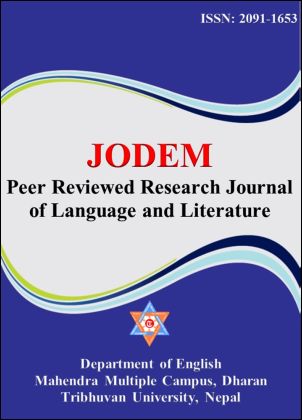Structural Analysis of Bhattarai’s Sukaratka Paila [Socrates Footsteps]
DOI:
https://doi.org/10.3126/jodem.v13i1.47461Keywords:
Narrative, structure, structuralismAbstract
This study aims at analyzing Govinda Raj Bhattaria’s novel Sukaratka Paila within the theoretical framework of structuralism. More specifically, this study uses the procedures of analysis called seek-find-lose and seek-but-don’t find grammar structure of narratives in which the major characters are studied. The idea is how one character seeks the other, finds him or her and again loses him or her. Bhattaria’s novel Sukaratka Paila embeds the structure of romance within the structure of full of irony and the second structure offers realities of the contemporary time when narrator professor Socrates realizes at the end when he sees Ananta's alike body hanging on the ceiling fan of his own room. The promises of living together being the life partners goes in vain for both Ananta and Purnima. Moreover, this study examines the structure of the novel in which structure plays an essential part in a literary work which juxtaposes the plot and other elements of the story to make the narration comprehensible for the readers and also to clutch the meaning which the novelist wants to convey. The prime purpose of the paper is to unfold the underlying assumptions and unconscious regularities of human characters and their experiences based on their behaviors, society and culture. This analysis captures the writer’s intention of fabricating the story through its characters, theme and setting. The study reveals that structural reading of a fiction paves the ways for exploring another vantage of point in literary works.
Downloads
Downloads
Published
How to Cite
Issue
Section
License
© Department of English, Mahendra Multiple Campus, Dharan, Nepal

